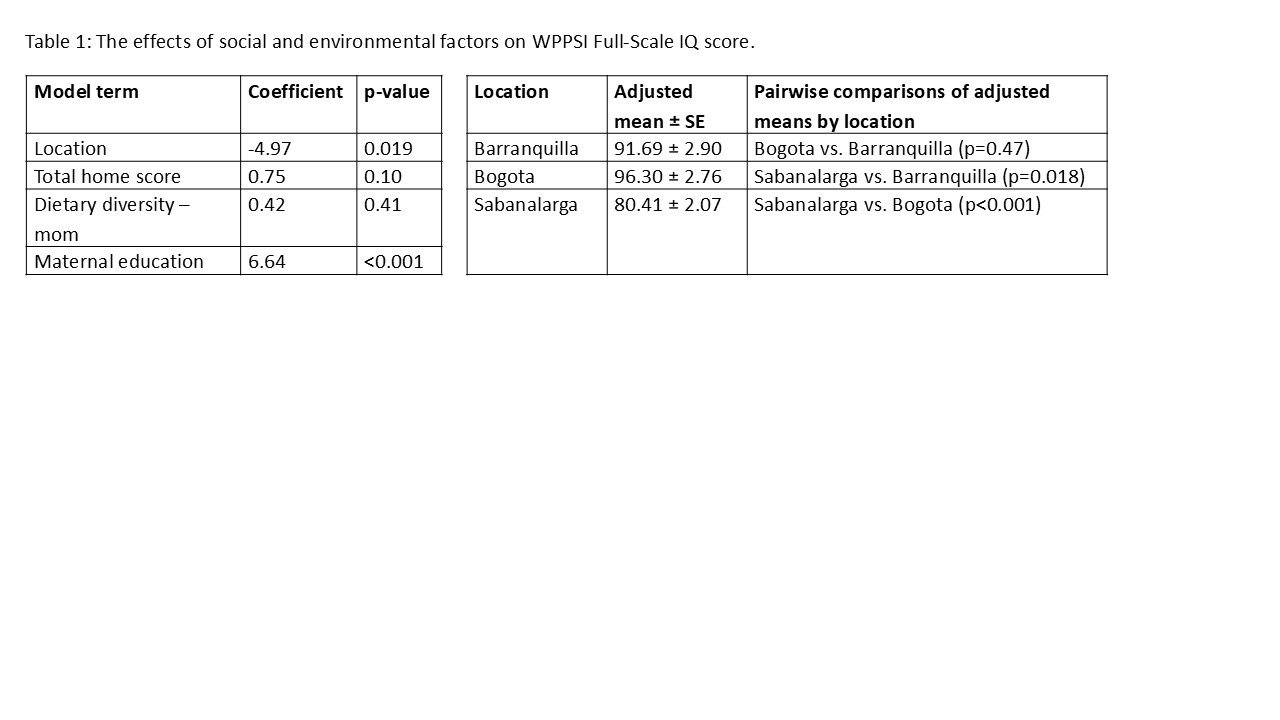Global Neonatal & Children's Health 1
Session: Global Neonatal & Children's Health 1
730 - Social and environmental influences on the cognitive and social-emotional developmental outcomes of rural and urban Colombian children at early school age
Friday, April 25, 2025
5:30pm - 7:45pm HST
Publication Number: 730.6836
Regan Andringa-Seed, Children's National Health System, Washington, DC, United States; Laura Calderón Suarez, Children's National Health System, Washington DC, DC, United States; Madison Berl, Children's National Hospital, Washington, DC, United States; Elizabeth Corn, Perelman School of Medicine at the University of Pennsylvania, Philadelphia, PA, United States; Heather Gordish-Dressman, Children's National Health System, Washington, DC, United States; Meagan Williams, Children's National Health System, Washington, DC, United States; Margarita Arroyave-Wessel, Children's National Health System, Washington, DC, United States; Carlos A. Cure, BIOMELAB SAS, Barranquilla, Atlantico, Colombia; Sarah B. Mulkey, Children's National Health System, Washington, DC, United States

Regan Andringa-Seed, BA (she/her/hers)
Clinical Research Coordinator
Children's National Health System
Washington, District of Columbia, United States
Presenting Author(s)
Background: Child neurodevelopment is shaped by complex social, environmental, and biological factors. In middle-income countries with diverse socioeconomic conditions like Colombia, understanding these influences is crucial. Little is known about how these factors specifically impact child neurodevelopment in this region.
Objective: To compare multi-domain neurodevelopmental outcomes in 5-year-old children in three different locations in Colombia and evaluate the contributions of social and environmental factors to disparities in outcomes.
Design/Methods: Our prospective study included 105 healthy Colombian children, age 5 years. 26 were recruited from Bogotá, 24 from Barranquilla, and 55 from rural towns in Sabanalarga (Figure 1). All participants were typically developing and had no chronic illnesses or developmental diagnoses. Measures included the Wechsler Preschool and Primary Scale of Intelligence (WPPSI) and caregiver-completed questionnaires: Behavior Rating Inventory of Executive Function (BRIEF), Child Behavior Checklist (CBCL), socioeconomic, home resources, and nutrition surveys. A descriptive analysis characterized the distribution of outcomes and covariates. We compared outcomes across locations with Sidak-corrected one-way ANOVAs. The impact of each covariate on outcomes and the inter-relatedness of covariates was assessed with Spearman/Wilcoxon tests, followed by a multivariable linear regression model considering significant covariates.
Results: Mean (SD) WPPSI full-scale IQ score in the Sabanalarga group was 76.0 (±13.6), compared to 96.7 (±14.1) and 100.9 (±11.2) in the Barranquilla and Bogota groups, respectively. All WPPSI indices except Verbal Comprehension differed between cities (p < 0.001), with the Sabanalarga cohort significantly lower. CBCL Externalizing Problems and BRIEF Cognitive Regulation Index were also lower for Sabanalarga (p < 0.001). The regression model revealed that maternal education was the strongest predictor for these differences, accounting for 50% of the variance in WPPSI scores when combined with location, dietary diversity during pregnancy and home resources (Table 1). Time-based family activities, number of children in home, breastfeeding status, and food consumption scores were not significant predictors of IQ independent of location.
Conclusion(s): There are significant disparities in neurodevelopmental outcomes among Colombian children in rural and urban locations, with a high influence of maternal education, nutrition, and home resources. There is a need for further research to explore additional factors affecting child neurodevelopment in middle-income countries.
Figure 1: Locations in Colombia from which cohorts of typically developing children were recruited.
.jpg)
Table 1: The effects of social and environmental factors on WPPSI Full-Scale IQ score.
 Left: Multi-variable model assessing WPPSI Full-Scale IQ score and significant, non-interrelated covariates of location, total home resources, maternal dietary diversity during pregnancy and maternal education. Right: Mean WPPSI full-scale IQ adjusted by location and comparisons between locations. Covariates in adjusted comparisons were set to mean for combined locations.
Left: Multi-variable model assessing WPPSI Full-Scale IQ score and significant, non-interrelated covariates of location, total home resources, maternal dietary diversity during pregnancy and maternal education. Right: Mean WPPSI full-scale IQ adjusted by location and comparisons between locations. Covariates in adjusted comparisons were set to mean for combined locations. 
